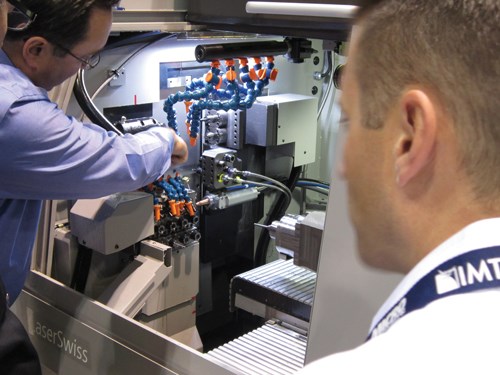Swiss-Type with Laser Cutting Capability
New capability for Swiss machines uses a laser.
Swiss-type turning did multitasking before multitasking was cool. Turning, milling, drilling tapping and other metalcutting operations have been part of the unique Swiss-type machine design for a century. Couple these mechanical capabilities to CNC and the sky seems to be the limit for the venerable sliding headstock design.
At the recently completed IMTS in Chicago, Rem Sales, exclusive North American importer of Tsugami machine tools, demonstrated a new machine with integrated laser cutting capability. The Tsugami S206-II is equipped with an in-house-developed IMG 400LS laser cutting system, which combines six-axis Swiss machining with the ability to laser cut workpieces.
Featured Content
It was a show stopper that takes Swiss-type machining another step forward in the race to machine parts complete in a single handling. Multitasking capability continues to grow as customers demand machines that can eliminate secondary operations.
To accomplish what this Swiss laser can do would traditionally require the turning, milling drilling and other operations to be performed on the Swiss. Then the intricate laser cutting would be performed on another, more dedicated machine, requiring two machines and the handling needed to move the parts.
According to Dale White, IMG laser product manager, “The beauty of this system is that it can be used as a regular Swiss turning machine when that is all that’s required and used for laser cutting if the application requires it.” This is the essence of multitasking, and for some medical, aerospace, electrical and other complex small parts, this flexibility can make the difference between a “no quote” (if a Swiss shop doesn’t have a laser) and a satisfied customer.
The new Tsugami “Swiss Laser” was designed and built by Rem Sales’ sister company, Innovative Machinery Group (IMG). The company is quick to point out that the IMG laser is not simply an attachment to the machine, but is an entirely new system fully integrated with the machine.
“This is not just a Swiss machine with an attached laser,” Mr. White says. “We didn’t just bolt a laser head onto the machine and give it a couple ‘M’ codes. This is a fully integrated system that operates on a single software platform.”
All of the laser cutting operations are programmed and driven from the machine’s FANUC 32i-B CNC. The nozzle standoff adjustment and the laser’s frequency, pulse width, focus and power settings are all adjustable “on the fly” through programmed commands in the machine’s control.
During the development process, IMG’s designers consulted with industry-leading software and laser engineers and then invited Tsugami customers to evaluate the initial design. “The Swiss Laser machine was unchartered territory,” says Mr. White, “so we want any and all input to help us get it right. Their comments resulted in better ways to mount the laser while maintaining full, interference-free operation of a lathe.”
The new Tsugami S206-II is an opposed gang tool lathe that features a Y-axis tool post for accessing complex part features while using the main and backworking spindles simultaneously. Moreover, the machine is “convertible,” meaning it can operate as a traditional sliding headstock Swiss using a guide bushing or with the guide bushing removed, operate as a chucker. In either mode, a bar feeder can be used for longer runs and lights-out operation.
The flexibility of a convertible guide bushing opens the machine up for a larger variety of workpieces since many parts run on these machines do not meet the length-to-diameter ratios that define traditional Swiss parts. Instead, setting the guide bushing for blanks or barstock that don’t need the guide bushing, job changes over can be reduced by simply removing the guide bushing and programming the Z-axis stroke to extend further into the cutting zone.
Operating the machine in either of these modes does not interfere with the operation of the laser when it is needed for a workpiece. If the laser is not involved processing a part, it does not interfere with the Swiss machining.
A high pressure coolant system gives flexibility over pressure and volume. In addition, the system used in the Swiss Laser also provides control over mist and velocity of the coolant in the workzone.
Although making watch parts, electronics and other small, precision components is still a significant market for the Swiss machines, medical applications have been growing by leaps and bounds. As a result, many Swiss turning shops are branching from traditional machining technology into finding other ways of making parts for their customers.
These shops embrace multitasking in part because of its flexibility and throughput abilities, but also because it can add machining processes beyond only turning. The Swiss Laser represents the step in this direction and reflects the continued integration of machining strategies made possible by combining mechanical and electronic technologies in new, different and productive ways.
RELATED CONTENT
-
New Line of Swiss-Types for Job Shops Eyeing High-Production Work
Mazak now offers the Syncrex line of Swiss-type CNC lathes — its first — targeting machine shops getting into higher volume production of complex parts.
-
How to Get More Efficient Production from Swiss-Type and Multitasking Machines
SolidCAM for multi-axis Swiss type and multitasking machines provides a very efficient CAM programming process, generating optimal and safe Mill-Turn programs, with dramatically improved milling tool life.
-
A New Approach to CNC Turning
This turning process takes advantage of a turn-mill’s B-axis spindle to vary a tool’s approach angle to optimize chip control and feed rates.











